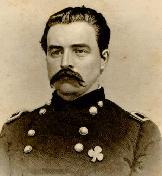

 " Thomas Alfred Smyth " was born in the parish of Balleyhooley, county of Cork, Ireland, on December 25, 1832. He received his education there and worked on his father's farm until immigrating to Philadelphia in 1854. Smyth worked as a wood carver during his life. He joined up with William Walker's expedition to Nicaragua in the mid-1850's. After returning from the expedition he settled in Wilmington, Delaware in 1858 and became a coachmaker. " Smyth " raised a company at the beginning of the Civil War, which became one of the companies in the all-Irish 24th Pennslyvania Infantry. However, this regiment only served three months and was disbaned. He was soon there after appointed major of the 1st Delaware Infantry, which enlisted for three years. " Smyth " was promoted to " Lieutenant Colonel " of the regiment in December 1862 and then " Colonel " in February 1863. The 1st Delaware Infantry fought at Suffolk, Sharpsburg, Fredericksburg, Chancellorsville and Gettysburg. " Smyth " later led his regiment with distinction during the Rappahannock Campaign of 1863 and in the fighting in the Wilderness to Petersburg in 1864.  The 1st Delaware Infantry's baptism of fire began with the order to charge the Rebel's defensive position in the sunken road at Sharpsburg. A Rebel observer reported that the Confederate fire " brought down the enemy as grain falls before the reaper. " Of the 650 members of the regiment that went into the charge, only 364 were left in the ranks after they were forced to retreat. Their next battle was in December at Fredricksburg, and " once again " the 1st Delaware Infantry was ordered to make a " suicidal charge ", this time against the Confederate position in front of Marye's Heights. The unit's formations collapsed before the barrage of fire and, seeking any cover, the men were not able to retreat until nightfall hid them from the view of the Rebel riflemen. At the July 1863 Battle of Gettysburg " Col. Smyth " was promoted to be the new commander of the 2nd Brigade of the 3rd Division of the 2nd Corps. The 1st Delaware Infantry, being part of " Col. Smyth Brigade ", avenged the slaughter at Marye's Heights when they helped to repulse the Rebel charge on the battle's third day in what has become known as " Pickett's Charge ". " Col. Smyth's Valor " in battle led to his promotion to " Brigadier General " on October 1, 1864. He commanded his brigade in the battles of Deep Bottom, Gravelly Run and Hatcher's Run. " Gen. Smyth's Brigade " was active in the pursuit of Lee's army in it's retreat toward Appomattox Court House. On April 6, 1865 when " Gen. Smyth " made his last entry in his diary he was commanding the 3rd Division of the 2nd Corps. His last entry stated: " At 6 o'clock assaulted the enemy's works. " The attack on the fortifications at High Bridge was successful. " Gen. Smyth's " troops crossed the span and pursued the retreating Confederates toward Farmville, Virginia. As " Gen. Smyth " rode along the skirmish line during this final battle, a sharpshooter's bullet struck him in the left side of his face, knocked out a tooth and continued into his neck, fracturing a cervical vertebra and driving a fragment of bone upon his spinal cord, resulting in complete paralysis. " Gen. Smyth " was taken to a nearby house where a hospital had been established. The next day he was transported by ambulance to Col. R.P. Burke's home, two miles from Burkesville, where he died the next day, April 9, 1865. His remains were sent to Wilmington, Delaware, where he was buried in the Wilmington and Brandywine cemetery. as fate would have it, was the last Union general to die during the Civil War !
to view General Smyth's "Find A Grave" record.



Russ Pickett Last update: 7/15/2007 |

